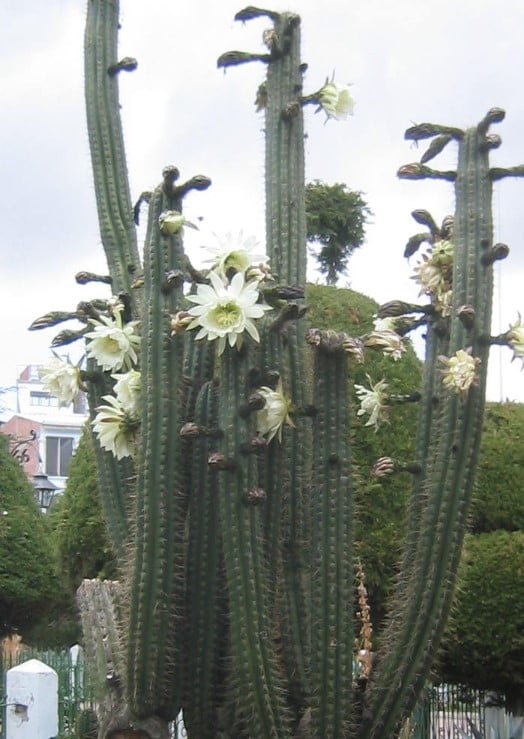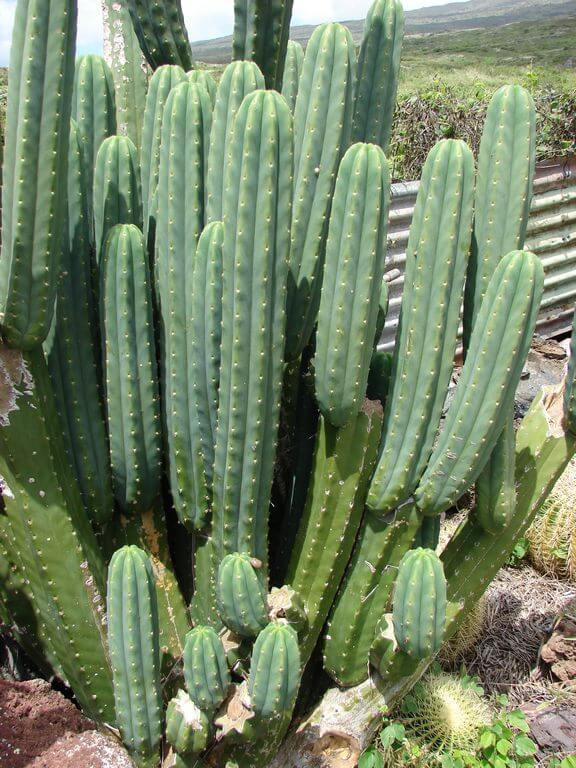The San Pedro Cactus (Echinopsis pachanoi) native to Andes region of Peru and Ecuador and has a columnar appearance.
It is also known as Trichocereus pachanoi or Echinopsis peruviana. This cactus contains psychoactive alkaloids, such as mescaline, which can produce psychedelic effects when consumed. San Pedro has been used for centuries in traditional medicine and spiritual practices, including religious divination.
San Pedro’s unique appearance makes it a popular ornamental cactus. It has dark green stems that can reach up to 12 feet tall, with wide ribs and spines. The cactus is known for its high concentrations of mescaline, but it can be found in a wide range of other psychedelic substances such as 3-methoxytyramine HCl.
San Pedro naturally grows in the Andes Mountains, but it can also be found in North America. It is often used for ornamental purposes, although some people like to consume it for its psychedelic effects. In some parts of South America, San Pedro is still used ceremonially for religious divination or healing purposes.
Psychoactive Alkaloids and Psychedelic Effects
Psychedelic compounds are known to produce powerful effects on the mind, and they have been used throughout history for spiritual and medicinal purposes. One of these compounds is mescaline, which is found in high concentrations in the San Pedro cactus (Echinopsis pachanoi).
The effects of consuming mescaline from the San Pedro cactus can include vivid visual disturbances, intense changes in perception, feeling of connection with nature, heightened sensory experiences, and altered states of consciousness.
It is important to note that although some people may experience positive effects from consuming this compound, it can also be dangerous if used without proper knowledge or guidance. Therefore it is best to consult an experienced psychonaut before attempting any psychedelic journey.

Physical Characteristics
San Pedro cactus (Echinopsis pachanoi) is a stunning cactus with a hard, dark green skin that can reach up to several feet tall in its natural habitat. It has numerous ridges and spines that protect it from predators, as well as providing an ornamental look.
San Pedro’s dark green coloration allows it to blend in with its surroundings and escape the attention of hungry animals. The bright yellow flowers that appear during springtime add another layer of beauty, making this cactus an attractive addition to any garden or collection.
Natural Habitat
San Pedro cactus (Echinopsis pachanoi), also known as Peruvian torch cactus, is a columnar cactus native to the Andes mountains of South America. Its natural habitat is in high altitudes and dry climates, where it can be seen flourishing on rocky slopes and in open grasslands. San Pedro’s growth rate is fast and it can reach heights up to six feet in a year.
Its hard, dark green skin helps the plant survive temperatures ranging from -2°C to 40°C. The bright yellow flowers that appear during springtime add an extra layer of beauty which makes this cactus an attractive addition for any garden or collection!
Range Of Mescaline Content
San Pedro cactus (Echinopsis pachanoi) is well known for its psychoactive alkaloid content, specifically its mescaline concentrations. Mescaline is a psychedelic substance that has been used in traditional medicine and religious divination for centuries.
San Pedro’s contain varying concentrations of mescaline, ranging from 0.01-0.7% by weight, depending on the species and growing conditions. The highest mescaline concentration is found in Echinopsis peruviana, which can reach up to 3-methoxytyramine HCl.
Although most people are familiar with the popular San Pedro cactus variety, it should be noted that there are many other varieties of Echinopsis cactus which contain different amounts of mescaline and can be used for ornamental purposes with no psychedelic effects.
History
San Pedro cactus (Echinopsis pachanoi) is a columnar cactus native to South America, where it has been used for centuries as an ornamental and spiritual plant. Although the cactus can reach heights of up to 20 feet tall, its dark green stems are usually no more than 6-8 inches in diameter.
This particular species of cactus has also been used by indigenous people in Peru and Ecuador for its psychoactive mescaline content. Over time, this popular hallucinogenic has become well known throughout North America. San Pedro’s contain varying concentrations of mescaline, ranging from 0.01-0.7% by weight, depending on the growing conditions. Despite its potential psychoactive properties, San Pedro remains a beautiful addition to any garden or outdoor space – just be sure to admire from a safe distance!
Ornamental Uses in North America
San Pedro cactus (Echinopsis pachanoi) is a columnar cactus native to Peru and Ecuador, but has recently gained popularity in North America as an ornamental plant. This species of cactus can reach heights of up to 10 feet tall, with a wide range of colors from dark green to yellowish-green. It is highly valued for its unique beauty, making it a popular subject for home gardeners and landscapers alike.
However, what many people do not realize is that this species of cactus contains mescaline concentrations – a powerful psychoactive alkaloid which provides hallucinogenic effects when ingested. Thus, it is important to be aware of this fact before bringing San Pedro’s into your home or garden. While the ornamental possibilities are certainly attractive, care should always be taken when dealing with this species of cactus.
Cultivation and Care
Cultivating and caring for a San Pedro cactus (Echinopsis pachanoi) is no small task. While it may look inviting with its unique beauty, this species of cactus requires careful attention in order to thrive.
To begin with, the plant should be planted in well-draining soil and placed in an area that receives plenty of sunlight. From there, regular watering is necessary to keep the soil moist but not soggy. Finally, occasional fertilization will give your San Pedro an extra boost and help ensure its growth and health.
To take care of your cactus, you should watch out for bugs that can harm it like mealybugs or scale insects. Look for signs of these pests on your plant and take action right away if you see any.
Growing Environment Requirements And Propagation
Growing a San Pedro cactus (Echinopsis pachanoi) requires a specific environment in order to thrive. This columnar cactus native to South America is best suited for areas with plenty of sun, such as the southwestern United States or Mexico. The soil should be well-draining and fertilized regularly to ensure optimal growth and health.
To grow more of this plant, you can either use seeds or cut a piece of it from the bottom. Be careful not to damage any part of the plant while doing this. If you choose to cut, make sure each piece has at least one bud so that it can produce new growth and roots.
Conclusion
The San Pedro cactus is a dark green cactus from Peru and Ecuador. People use it in religious ceremonies. It has psychedelic substances in it. People in North America grow it for decoration. To get the best results, people need to think about where it grows, how old it is, and how big it is.
Please note / Disclaimer: I am not a medical expert or veterinarian, all the information we write and present here is only for sharing based on what the author knows so far. For this reason, we recommend that you always consult the expert directly (medical doctor or veterinarian). We disclaim all responsibility for anything including: poisoning, accidents and the like that we write about on this blog.
